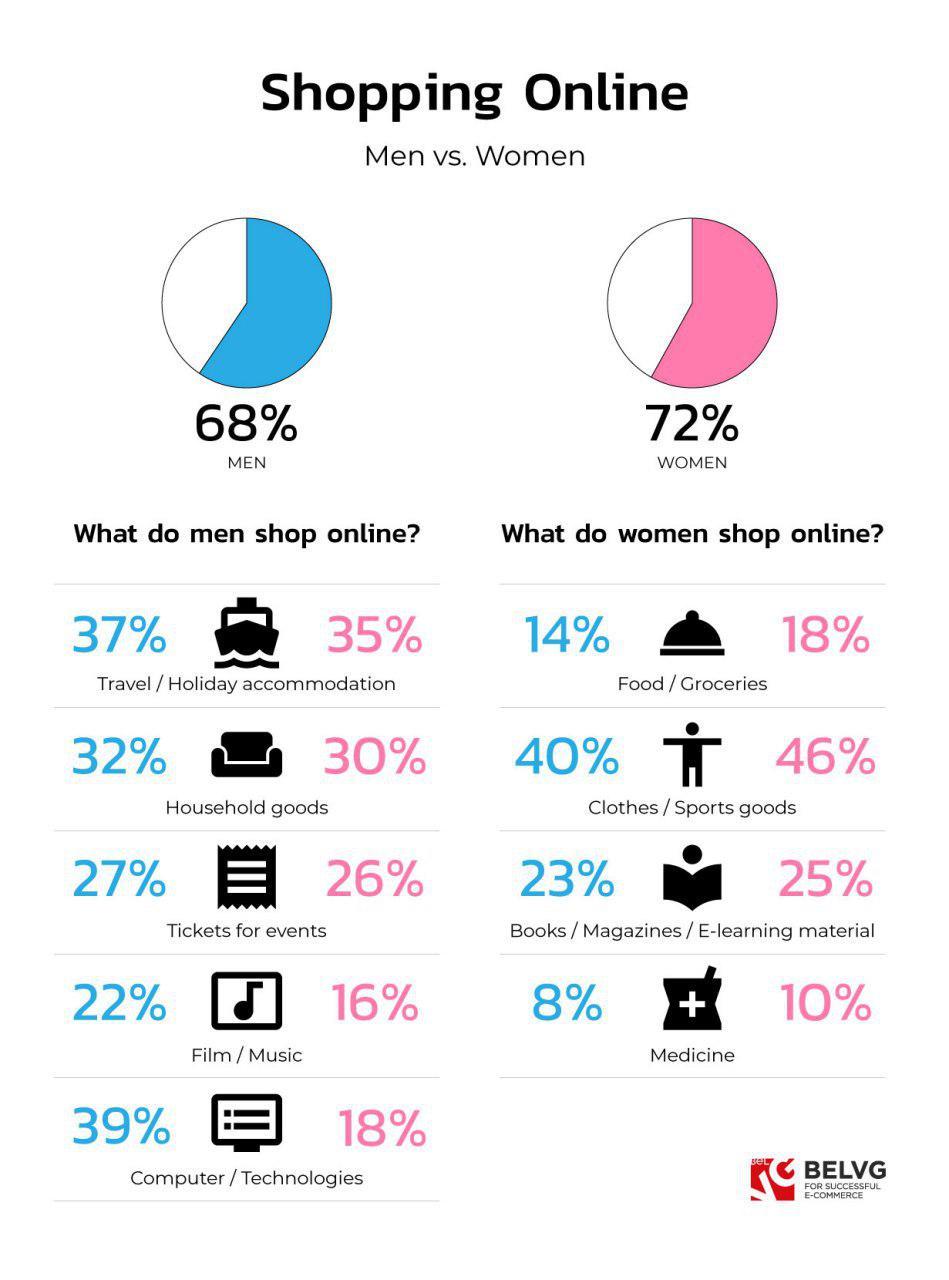
It has always been so – he who owns the information, owns the world, and the same applies to the world of ecommerce. It’s not an issue anymore to offer a wide product range; the online retailers today face the hardship of how to reach the right customer with the right message, offer them the product they will be most satisfied with and provide the shopping experience that will make them want to come back to your online shop. Understanding the importance of customer data, merchants nowadays are actively engaged in gathering and analyzing any information.
It’s a common knowledge that men and women have different mentalities that determine both sexes’ perspectives, motives and behaviors. Whether this difference is the question of nature or nurture is debatable, but the fact remains and has always been the point of particular interest to brands and merchants. Since the Internet has taken over numerous aspects of our life, and commerce in particular, marketers and advertising specialists are paying close attention to the peculiarities of online shopping behavior among women and men. In today’s article we will take a closer look at the core online shopping behaviors and dynamics of men and women.
Table of contents:
General shopping habits
How men and women shop online
What do men and women shop online for
General Shopping Habits
One should begin their journey into the difference between two sexes with exploring general shopping habits and behaviors. Being aware of differences in shopping habits, behavior and dynamics can help you make the first step in marketing campaign diversification and advertisement targeting.
In general, a slightly larger percentage of women than men opt for online shopping (72% of women, 68% men). The reasons why approximately 30% of both sex customers prefer to visit brick-and-mortar shops are mostly the same:
- the capability to put on, touch and feel the item,
- human interaction with consultants or shopping mates,
- online shops raise their information security concerns,
- unwillingness to wait long shipping terms.
As for the reasons why men and women opt for shopping via the Internet, that is when the differences between sexes manifest themselves.
According to behavioral studies, while shopping online men tend to be more:
- focused on the mission; men consider shopping as a common activity with one straightforward goal – purchase;
- logical – men are largely driven by reason, not emotion or someone’s opinion;
- reliant on product information – males usually carefully study features of an item before making a decision;
- resistant to special offers, discounts, and sales, and less frequently take them into account when making the decision to purchase or not;
- interested in the result – not captivated by the process, men make a purchase as soon as the suitable item is found.
Women, on the other hand:
- enjoy the shopping process as a whole and tend to spend more time shopping online;
- make up their mind based on reviews and ratings, not specific features of the item;
- tend to follow trends and fashion, and make the purchasing decision with them in mind;
- tend to make impulse and unplanned purchases, triggered by advertisement, special offer or sale, personal recommendation, desire to improve mood, etc.;
- are more selective, searching not for the item they need, but the one that will suit perfectly.
How Men and Women Shop Online
The next crucial aspect for online merchants for building proper interaction with customers of both sexes is understanding HOW they make purchases online and WHAT do they prioritize in their purchase.
According to the statistics, men prove to be more technically adept than women in online shopping. 45% of men use a smartphone or a tablet for purchasing online, compared to 34% of women. On the other hand, the gap between the percentage of males and females that utilize laptops or PCs for web purchases is not especially wide – 82% of women and 85% of men.
It is a common knowledge that when it comes to making a decision about the purchase, there are always a variety of small things, or nuances, that come into play and influence final resolution. Here is the list of things that matter to men and women in different proportion:
- free shipping – is equally important (to 60% of both men and women);
- best bargain – matters nearly equally (to 74% of men and 77% of women);
- buying on sale – is more crucial to women (74% compared with 57% of men);
- applying coupons or promo codes – women tend to care about it more than men (34% of females and 26% of males);
- study promotional emails – women are more curious, so they open them more frequently (14% of women and only 8% of men).
What Men and Women Shop Online For
The aspect of WHAT is being purchased by males and females is surprisingly often regarded as the case solved and closed long ago – men purchase gadgets and technology, while women are obsessed with fashion items. On the one hand, this assumption can’t be called an entirely false one. On the other – this is a rough generalization that merchants accept and put into the base of their brand positioning as well as marketing and advertising campaigns. At the time when sex and gender stereotypes are largely cast off and rethought, it is inappropriate and harmful to a store or a brand to follow them blindly. Instead, base your marketing concepts on proven statistical data.
According to the research, males shop online for:
- Computer and tech (39%, compared to 18% of females);
- Travel and holiday accommodation (37%, compared to 35% of females);
- Household items (32%, compared to 30% of females);
- Tickets for events (27%, compared to 26% of females);
- Media content – movies and music (22%, compared to 16% of females).
The fair sex, in their turn, purchases online the following items:
- Clothes and sports goods (46%, compared to 14% of males);
- Books, magazines and electronic educational literature (25%, compared to 23% of males);
- Groceries (18%, compared to 14% of males);
- Medicine (10%, compared to 8% of males).
Wrapping it up
As you can see, the differences between male and female purchasing behavior and tendencies exist, but it is not that huge and significant to oppose both sexes in your marketing campaigns. We assure you it is possible to create a genderly well-balanced marketing campaign that will be as interesting as the one based on common stereotypes.







Its very amazing information. thank’s for sharing.
Good news for online merchants, Shiza :) You could probably be interested in our recent blog article addressing COVID-19 impact on ecommerce sales worldwide. Here is the link: https://belvg.com/blog/covid-19-impact-ecommerce.html
online shopping in pakistan is going good because of COVID 19 before this coronavirus no one shop online :D
Thank you :) We are glad you’ve liked it!
Your article is wonderful! I would like to share your article on my website. You can visit my website and check how your article introduced.
Thank you for sharing an informative blog. I have learned from you something different today.